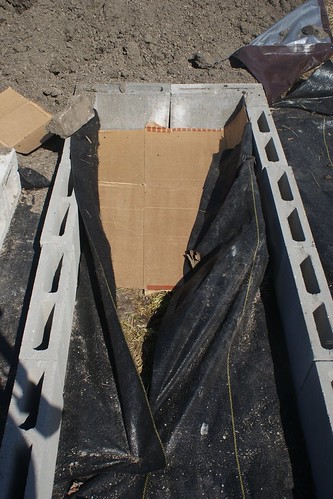Sunday, April 7, 2013
Here Comes the Dirt!
We had the benefit of some beautiful, truly spring-like weather this weekend, and tried hard to utilize it.
I spent saturday doing mostly cleanup work... removing an old flower barrel out by the road, leveling out some old flowerbeds and relocating some poorly planned tree/shrub plantings that annually became weedy eyesores and made mowing (even) more difficult. I even spread some grass seed in the disturbed areas (but oh, how it pains me to actively plant the cursed stuff). The overall effect will be to smooth out and clean up the look of the frontage quite a bit, and make mowing the area more efficient.
We had 20 cubic yards of soil delivered on Saturday morning, and thankfully the driver was able to land it right next to/kinda on-top-of the beds we'll be filling. As I've learned, the less long-distance trips you have to make in the sun with a wheelbarrow full of soil, the better.
The landscaping fabric hasn't been down long enough to fully kill the grass, so for the beds that we're filling/planting first, I'm laying down cardboard under the soil to finish off the turf.
We cut and pulled back the landscaping fabric, laid the cardboard, and filled the beds with soil. Once the cardboard deteriorates, the soil in the beds will be in direct contact with the soil beneath.
We planted our first direct-seeded crops tonight as well, seeding one of the two beds we filled... a double row of Sugar Sprint snap peas, two rows of German Giant radishes, and a row of turnips.
We took a break for a few hours out to go take Heidi on a walk around the park in Richwood, and got some ice cream. We also scored some more cardboard from the recycle-dumpster in town.
At the rate we're going, a few more solid work days and we should have the new garden beds filled and planted.
Subscribe to:
Post Comments (Atom)




Looking good! I'm really glad to see that you are cutting the fabric back from under the beds. I think it is important to have that direct earth contact so that insects, worms, and soil can migrate in and out.
ReplyDeleteOur goal exactly! I haven't gone into this in detail on the blog, but part of the reason we're doing raised beds this way in this area is because of the nature of the ground there.
DeleteThis area used to be where they drove heavy machinery when this place was a working farm. So there's maybe an inch of heavy clay soil/turf, and then gravel underneath, so we couldn't really work with the existing ground. Hence the raised beds in this particular area.
This also part of our Zone 1/intensive annual cultivation area. For this we've found the raised beds to be a crucial timesaver when it comes to weeding, etc. In other areas on the property with better workable soil, we'll be doing less raised beds and more in-ground plantings.